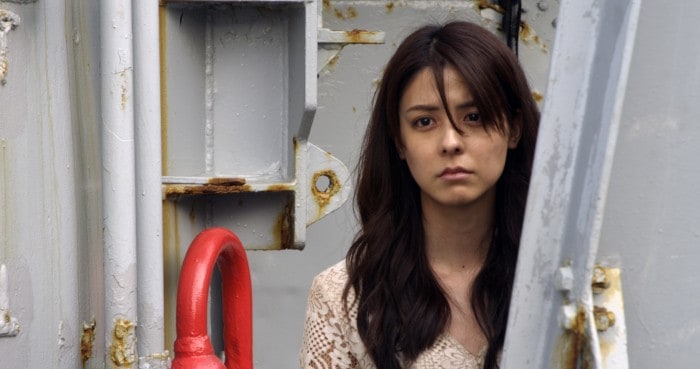People from various backgrounds set sail on a warship. Within these various backgrounds exists a class system that mimics that of modern society, a system which puts certain people into a life of luxury. This includes a politician, his son, the ship crew, and a group of violent thugs. The elite come up against the lower class, which includes families, students and prostitutes. The inequality between the groups is felt early in over the protests of special treatment allotted to the upper class and physically strong. In spite of the strong divide, the two classes do attempt to find some common ground at the start of the trip.
“Human, Space, Time and Space” is screening at Florence Korea Film Fest

After a night of debauchery and substance abuse, the worst attributes of everyone results in a murder and a woman being violated multiple times. This despicable crimes act as a catalyst towards an otherworldly accident occurring on the ship. The event, which is somewhat foreshadowed by a silent figure collecting dirt from the deck of the ship, finds the crew suspended high in the sky with no sea or ground below. This bizarre scenario creates civil unrest as those in power look to control the flow of resources to the lower classes. As supplies dwindle, the lower class is consumed with hate, and even those in the upper ranks begin to act out as they realize that they too may run out of food. In order to carry on society, it is up to a young woman, aptly named Eve, to make a future for her child using the resources grown from the old silent figure that aims to protect her.
Fans of Kim Ki-Duk will be quick to point out his versatility and his ability to make compelling films with starkly different narratives and themes. Even with the director being able to switch themes between idyllic romanticism to bleak tragedy, there are some creative choices the majority of his productions contain which are noticeably absent in this most recent production. The most notable shift is utilizing a dialogue heavy script to tell his story. Although the director has worked with more scripted work before, the hefty concepts contained within the film further push away from the majority of his productions which relies more on silence pushing an open ended narrative onto the viewer.
The story, which exists as a religious parable, is a bit too literal of an interpretation of the concepts it lays out, and this really muddles the directors' talent at creating complex and interpretive story telling through silences. As a prime example, within moments of the introduction of the violent gang, it becomes apparent that their role in society is that of “The Military”. The gangs attitude, disgust for others as well as offered subjection to the political class, comes across as a service towards pushing a political narrative over creating a compelling work of fiction. This exists as one of the few examples within the production, as there are a lot of narrative choices that just feel very heavy handed for a director who excels most when leaving interpretation to its audience.

Within the choice to make a more defined narrative, Duk unfortunately seems to neglect one of his other talents within the film's visual work. Although the production is well shot and is good at capturing certain chaotic moments, it really falls short in visual presentation. The ship chosen works to frame the story, but there is nothing to draw the eye or create awe within the set. The ship is very lifeless, and to have a location like this utilized in a Duk film feels like an injustice to the directors' visual styling. Once again, with the theme being maybe too literal, the ship appears to represent Noah's Ark, but the film could have kept the story of the the idea of the Ark but applied it within a more visually intriguing environment. It is a bit disheartening with this not being the first film taking place largely on the water, and not even the first of his productions taking place entirely on a ship. When drawing comparisons to previous work “Human, Space, Time and Human”, has very little to offer. Perhaps the most successful technical choice lies in the soundtrack as it does succeed in building on the tense atmosphere. It is also sparingly used, and stays almost muted at times. The music kind of seems to drop in and out of being noticeable, but always in a complimentary way to the narrative.
In regards to the performances it does become difficult to offer critique. The performances will become more compelling based around the societal role each actor represents and less on the performances themselves. This can be contributed to the size of the cast not allowing for deeper connections as well as being told upfront as to which characters should be condemned and which should be championed. Again, another creative choice which seems to be counter intuitive to the directors' strength, as he often exceeds in blurring the lines of moral good and evil. The one performance that stands out is with Sung-Ki Ahn, who plays the silent figure trying to create a future for the unborn. Showing strength in his silence, the old man becomes the only ambiguous character whose role and motives make him more open for interpretation. Regardless, the way he methodically goes through the steps with little emotion in order to save the young woman, makes him a fascinating character. Thankfully, other than the cast that exists just to yell out disgust and fear at their predicament, none of the key performances feel like they drag the others down. Everyone does exist to compliment the other cast, and they play their assigned roles with conviction, which saves a lot of the production from becoming mundane.

Although the script feels a bit at odds to the directors' visual storytelling, the story does become compelling and has a great, albeit predictable, build up. The desperation and fear of the crew are always at the forefront of the story and is well conveyed, with the climax of the film in particular, where everything breaks down into chaos, acting as a visceral sequence of extreme violence and inhumane actions. The climax alone saves a lot of the production's shortcomings, the chaos is so enthralling and disturbing, and the executions that take place rival the disturbing scenes in the directors other productions.
Unfortunately, this follows up with an ending which many will find deflating. In order to avoid spoilers I will not offer to much commentary, but it will act as one of the more divisive endings the director has produced.
When reflecting on “Human, Space, Time and Human” it was hard to come up with mostly criticisms of a director who was really at the forefront of pushing my interest into Korean film. However, with any of the directors works, I never feel like I walk away upset with the outcome, and even within the fan base, I know the films which people find most compelling can vary. But even within the varying opinion of the directors best works, I find it doubtful that many would point to this as an example of how they grew to admire the films of Kim. If viewed outside of the directors previous works, it is still a strong film, whose climax in particular creates a strong emotional and visceral connection to the content. “Human, Space, Time and Human” is not necessarily a bad film, but as a fan it is hard not to feel a bit let down and instead have the mind wander to other productions where he was much more successful in executing his social message within a more visual appealing and/or intriguing narrative.















